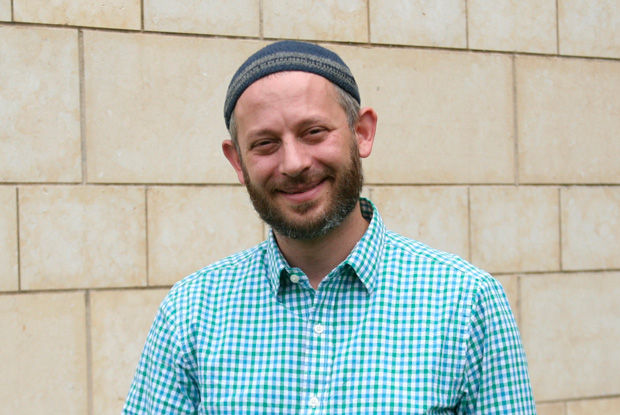D’var Torah: The Holy Blessed One’s ‘human-affirming’ care
Published October 21, 2022
Parashat Bereishit rolls in this week to remind us that we humans are all works in progress who need each other and probably a little divine care to live into our fullest selves. We see this clearly when we take a closer look at the sections of this week’s parasha describing the creation of humanity. When we read the first chapter of Genesis, we see something curious. Unlike many of G*d’s other acts of creation, G*d does not utter the recurrent refrain of “it was ‘tov’ (good / sustainable)” immediately after creating the human (1:26). G*d’s ensuing actions would seem to indicate that the human’s physical and emotional health require support and development in order to attain “tov (good / sustainable)” status.
G*d cares for the human in ways that recognize, affirm, and address the human’s physical needs and drive for self-actualization. Many traditional commentators recognize that creating humanity in the divine image (1:27) G*d means that G*d endows humanity both with the ability to understand the world and the agency to modify the world for our own purposes. What a gift not only to be able to understand the world and to be able to interact with it in ways that are personally and socially beneficial, but also to be conscious of these abilities! G*d further blessed the human–giving them power to increase in number (1:28) so that they might build both family and community. G*d then entrusts the human with responsibility for fish, birds, and land animals and assigns the human to land (1:28), giving them a sense of “home.” Finally, G*d teaches the human and all animals that fruit trees and all green plants are available as nourishment(1:29-30). Only after providing for the human’s sustainable development does G*d step back to get a more holistic perspective on all of creation (1:31), calling the whole of creation tov me’od (very good / very sustainable).
The human-centered creation narrative of chapter two makes an even starker point of the ways in which G*d does not initially create the human as fully tov, but does, ultimately, provide for the human’s sustainable development. In Genesis 2:18, we see the first example of something being called lo tov (not good / not sustainable):
ADVERTISEMENT
A-donai Our G*d said, “It is not good for the human (Adam) to be
alone; I will make him a corresponding helper.”
G*d calls the existence of the human “lo tov.” In her book, The Soul Of The Stranger: Reading God And Torah From A Transgender Perspective, Yeshiva University professor Joy Ladin puts it this way:
The man has a body, a soul, a home, work, food to eat, a
Relationship with G*d, and the beginning of morality, but he is not
yet fully human, because though some of us enjoy living in
solitude, as a species, human beings are social animals. As G*d
reflects in verse 18, ‘It is not good for man to be alone.’ ” (26)
After careful observation, conversation, and trust-building G*d provides Adam the requisite care to create a helpmate. Consequently Adam better identifies with himself and recognizes his helpmate. Upon waking to see that G*d had taken part of his side to create Eve, Adam exclaims, “This-time, she-is-it! Bone from my bones and flesh from my flesh! She shall be called: Woman/Isha, for from Man/Ish she was taken!” (2:23) G*d excises a part of Adam to create an “other” which Adam, in turn, recognizes as both “self” and “other”–his corresponding helpmate. This allows him to live into a stronger, more authentic personal identity–in relation to one who he recognizes as both similar to and different from him.
Previous to this moment G*d had created and named physical differences between masculine and feminine in the human, but there were no gender distinctions in roles, responsibilities, food to be eaten, or hierarchy. As Dr. Ladin points out later in her book, the instant in which Adam recognizes Eve as both self and other is precisely the moment where Adam creates the social construct of gender–indeed a gender binary–by naming “man” and “woman.” Adam creates gender as a way of naming a difference that can bring himself and another together.
For many of us, gender and the way we express our gender are core to who we are, how we see ourselves, and how we connect with others. Data from more than a dozen studies of over 30,000 transgender and gender-diverse young people consistently shows that being denied gender-affirming care is lo tov (not good / not sustainable), leading to higher rates of suicidality, depression, and self-harming behavior.* Of course use of temporary puberty blockers or sometimes even hormones can be ways in which we exercise our G*d-given understanding of the world and personal agency to support each other’s human development. Even surgery is occasionally be part of this care–as it was in G*d’s care of Adam. More often though, affirmation of a person’s identity, counseling, a sense of belonging, and socialization–as G*d provides Adam–are the kinds of care used to support healthy development of our personal and gender identities. Perhaps Adam’s enthusiastic response upon seeing his helpmate was a direct consequence of G*d’s attention to his full process of human development–the divine care that, in relationship to Adam’s developing self–provided him food, purpose, home, morality, a healthy gender identity, and a physical helpmate who, as a result of all that support, Adam had greater emotional capacity to love. May it be G*d’s will that we–created in G*d’s image–also merit to provide such divine care to our children and to each other.
ADVERTISEMENT
Rabbi Scott Slarskey is Director of Jewish Life at Saul Mirowitz Jewish Community School and a member of the St. Louis Rabbinical and Cantorial Association, which coordinates the d’var Torah for the Jewish Light.
* Boerner, H. (2022, May 12). What the Science on Gender-Affirming Care for Transgender Kids Really Shows. Scientific American. Retrieved October 16, 2022, from https://www.scientificamerican.com/article/what-the-science-on-gender-affirming-care-for-transgender-kids-really-shows/















